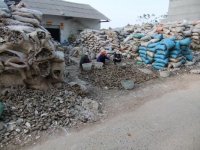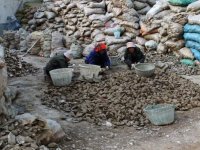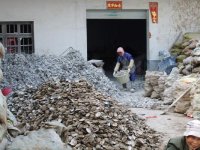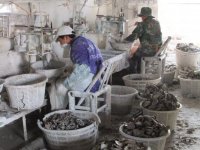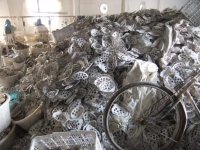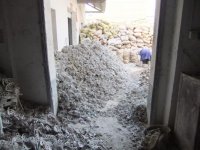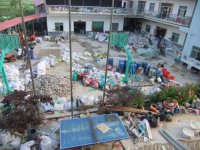Cyril Roger Brossard
Well-known member
- Joined
- Aug 30, 2012
- Messages
- 408
as seen here.
Published time: March 21, 2013 18:23

China?s coastal waters are experiencing severe pollution, with the size of the worst affected areas up 50% on last year according to The State Oceanic Administration (SOA).
The SOA, found that 68,000 square kilometers (26,300 square miles) had the worst official pollution rating, up 24,000 square kilometers on 2011, it was reported by the China Daily Thursday.
Affected waters are deemed unsuitable for swimming, fish-farming, port use and are not even fit for some industrial purposes under this classification.
The SOA statement found that pollution from 72 monitored rivers increased by 17 million tonnes in 2012 and included 46,000 tonnes of heavy metals and 93,000 tonnes of oil. While discarded plastic rubbish accounted for 80% of pollution in coastal waters.
?The pollution of coastal waters and damage to the eco-system remained acute,? the statement read.
The SOA found that the impact on China?s estuaries, including the Yangtze and Pearl River deltas, which are huge centers of population and industry, were particularly badly affected. More than 80% of the coast of the Bohai Sea in northern China is built up with factories and other construction projects, while only 5% was still in a natural state.
The data reflects China?s rising environmental problems, which are a result of its rapid economic growth and booming economy and have sparked widespread public anger and protests.
China?s leaders have promised action on the country?s appalling pollution problems. Protests have reportedly grown by almost 30% a year since 1996.
The results of an eight year marine survey, some of which were revealed by the magazine Nature in November last year gave a disturbing picture of the overall marine environment in China.
China?s mangrove swamps have shrunk by 73% and coral reefs by 80% since the 1950?s, while coastal wetlands have declined by 57%.
It also revealed that over the past 20 years China?s coasts have suffered repeated harmful algae blooms. There has been an average of 83 ?red tides? a year, called thus because of the red pigment in the phytoplankton species.
?Green tides? of green algae occur mostly in the Yellow Sea, while ?brown tides?, which kill shellfish, hit China in 2009.
As a result of the state of China?s coastal waters, some species of fish in the East China Sea are on the brink of extinction.
?There is an urgent need to set up a long-term monitoring network to access changes in coastal water chemistry and their impact on marine ecosystems,? Gao Kunshan, a marine ecologist, at Xiamen University, told Nature.
and also here.
By Wang Qian ( China Daily) Updated: 2013-03-21 07:09
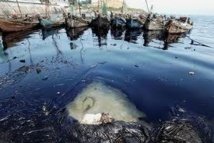
Increasing stretches of China's coastal waters were seriously polluted in 2012, mainly from excessive polluting discharges from land, the State Oceanic Administration reported on Wednesday.
The area of severely polluted Chinese coastal waters surged to 68,000 square kilometers in 2012 from 44,000 sq km in 2011, according to the country's 2012 marine environment report.
Guan Daoming, director of the National Marine Environmental Monitoring Center, blamed the worsening marine environment on surging human activity.
The report showed that the water quality near coastal regions that are crowded with factories and buildings has been worsening in recent years.
"Human activity is posing an increasing threat to marine life and habitats as the pollution escalates," Guan said.
According to the report, more than 17 million metric tons of pollutants from the 72 monitored rivers flowed into the sea in 2012. This included 46,000 tons of heavy metals and 93,000 tons of oil.
As the marine economy becomes a new growth area for China, coastal waters face great risks from booming offshore development and coastal construction.
According to the State Oceanic Administration, more than 80 percent of the Bohai Sea coastline was crowded with factories and construction projects, and less than 5 percent of the Bohai Bay's shoreline remained in a natural state.
The environmental impact from a Bohai Bay oil spill in June 2011 is still felt, with increased oil level in the waters near the accident site since the spill, the report said. Some marine experts said that it could take about 30 years for the bay to recover.
Besides Bohai Bay, about 53,074 cubic meters of drilling mud from offshore oil platforms was discharged into the nation's coastal waters, a year-on-year increase of 11 percent.
Plastic refuse accounted for 80 percent of the litter in the coastal waters.
Nearly 4,400 pieces of plastic refuse are found per sq km of water, and beaches have 50,000 pieces per sq km, the report said.
To better protect the fragile marine environment, Li Xiaoming, director of the department of marine environment protection under the SOA, said the oceanic watchdog is taking a series of measures to increase supervision and restrict pollutants discharged into the sea.
He added that a system will be set up to strictly control the effect of human activities on the bay.
More than 720 barrels of crude oil and 2,610 barrels of oily mud were released into the bay by spills in June, and together they polluted 6,200 sq km of water, the SOA estimates.
Published time: March 21, 2013 18:23

China?s coastal waters are experiencing severe pollution, with the size of the worst affected areas up 50% on last year according to The State Oceanic Administration (SOA).
The SOA, found that 68,000 square kilometers (26,300 square miles) had the worst official pollution rating, up 24,000 square kilometers on 2011, it was reported by the China Daily Thursday.
Affected waters are deemed unsuitable for swimming, fish-farming, port use and are not even fit for some industrial purposes under this classification.
The SOA statement found that pollution from 72 monitored rivers increased by 17 million tonnes in 2012 and included 46,000 tonnes of heavy metals and 93,000 tonnes of oil. While discarded plastic rubbish accounted for 80% of pollution in coastal waters.
?The pollution of coastal waters and damage to the eco-system remained acute,? the statement read.
The SOA found that the impact on China?s estuaries, including the Yangtze and Pearl River deltas, which are huge centers of population and industry, were particularly badly affected. More than 80% of the coast of the Bohai Sea in northern China is built up with factories and other construction projects, while only 5% was still in a natural state.
The data reflects China?s rising environmental problems, which are a result of its rapid economic growth and booming economy and have sparked widespread public anger and protests.
China?s leaders have promised action on the country?s appalling pollution problems. Protests have reportedly grown by almost 30% a year since 1996.
The results of an eight year marine survey, some of which were revealed by the magazine Nature in November last year gave a disturbing picture of the overall marine environment in China.
China?s mangrove swamps have shrunk by 73% and coral reefs by 80% since the 1950?s, while coastal wetlands have declined by 57%.
It also revealed that over the past 20 years China?s coasts have suffered repeated harmful algae blooms. There has been an average of 83 ?red tides? a year, called thus because of the red pigment in the phytoplankton species.
?Green tides? of green algae occur mostly in the Yellow Sea, while ?brown tides?, which kill shellfish, hit China in 2009.
As a result of the state of China?s coastal waters, some species of fish in the East China Sea are on the brink of extinction.
?There is an urgent need to set up a long-term monitoring network to access changes in coastal water chemistry and their impact on marine ecosystems,? Gao Kunshan, a marine ecologist, at Xiamen University, told Nature.
and also here.
By Wang Qian ( China Daily) Updated: 2013-03-21 07:09

Increasing stretches of China's coastal waters were seriously polluted in 2012, mainly from excessive polluting discharges from land, the State Oceanic Administration reported on Wednesday.
The area of severely polluted Chinese coastal waters surged to 68,000 square kilometers in 2012 from 44,000 sq km in 2011, according to the country's 2012 marine environment report.
Guan Daoming, director of the National Marine Environmental Monitoring Center, blamed the worsening marine environment on surging human activity.
The report showed that the water quality near coastal regions that are crowded with factories and buildings has been worsening in recent years.
"Human activity is posing an increasing threat to marine life and habitats as the pollution escalates," Guan said.
According to the report, more than 17 million metric tons of pollutants from the 72 monitored rivers flowed into the sea in 2012. This included 46,000 tons of heavy metals and 93,000 tons of oil.
As the marine economy becomes a new growth area for China, coastal waters face great risks from booming offshore development and coastal construction.
According to the State Oceanic Administration, more than 80 percent of the Bohai Sea coastline was crowded with factories and construction projects, and less than 5 percent of the Bohai Bay's shoreline remained in a natural state.
The environmental impact from a Bohai Bay oil spill in June 2011 is still felt, with increased oil level in the waters near the accident site since the spill, the report said. Some marine experts said that it could take about 30 years for the bay to recover.
Besides Bohai Bay, about 53,074 cubic meters of drilling mud from offshore oil platforms was discharged into the nation's coastal waters, a year-on-year increase of 11 percent.
Plastic refuse accounted for 80 percent of the litter in the coastal waters.
Nearly 4,400 pieces of plastic refuse are found per sq km of water, and beaches have 50,000 pieces per sq km, the report said.
To better protect the fragile marine environment, Li Xiaoming, director of the department of marine environment protection under the SOA, said the oceanic watchdog is taking a series of measures to increase supervision and restrict pollutants discharged into the sea.
He added that a system will be set up to strictly control the effect of human activities on the bay.
More than 720 barrels of crude oil and 2,610 barrels of oily mud were released into the bay by spills in June, and together they polluted 6,200 sq km of water, the SOA estimates.


